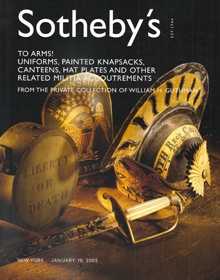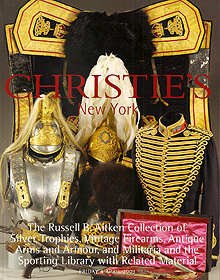Why It's Important
The Fine Art of History
It has been said that collecting is an "unruly passion". In fact, a book examining the psychology of collectors was published some years ago under that very title. I am acquainted with a neurologist, herself a collector of Chinese export porcelain, who assures me that specific parts of the brain will "light up" when an avid collector first spots a new or desired piece for their collection. We all know the feeling. It is true in differing degrees no matter what one collects - whether depression glass or Impressionist paintings. We have all seen it at shows, exhibitions and auctions. Most of us have experienced the feeling, whether we admit it or not.
For those of us who collect the "material culture" of military history, however, the "unruly passion" that begins with the collecting of only certain items in a series, often evolves to encompass a wide range of objects, military and domestic, which illuminate our particular area of interest. Soon, it becomes a passion for more than a particular item and is transformed into a desire to touch the history that the items represent. We want the fine art of history to touch our life and connect us with the people and events of another time and, often, another place.
We can see this in many of the truly great collections.

William H. Guthman (1924-2005) may have begun acquiring antique American firearms and martial longarms, but having purchased a silver inlaid pipe tomahawk (circa 1778) he entered a new world. In order to understand that time and place, Guthman became a student of the period. He "illustrated" his studies with new pieces for his collection - early uniforms, headgear, paintings and portraits - and he became a connoisseur of what he collected. Building his own extensive reference library, he added to the body of knowledge by writing his own books and articles. When his collection was sold at auction in 2003 and 2006, its extent, diversity and quality was truly astounding. Even the catalogs, that detailed the scope of his interests and research, became reference works in their own right. In attempting to describe his passion, Guthman said, "It boils down to the fact that I really collect early American history in objects and written words, in an attempt to acquire a complete picture of the period." It is also important to note that Guthman lived with his collection. Early American portraits and prints of the period adorned the walls of his home. A painted militia drum (with glass on top) might stand in for an end table. Federal ceramics lined the shelves of a painted (milk paint, of course!) breakfront, with some of the cabinet doors making use of period pictorial enameled knobs. An early colonial armorial fireback, served at the fireplace and early American chairs and tables were used as places to sit and serve. The objects that surrounded him in his daily life constituted "the fine art of history."

Still others approach collecting owing to their early training or vocation. The New York socialite Russell B. Aitkin (1910-2002) could have stepped out of the pages of a Hemmingway novel. A native of Cleveland, Ohio, he received his early training in journalism and art. He also enjoyed shooting and the outdoor life. During the 1930's, while receiving critical praise for his sculpture, he developed into a skilled marksman recognized in national and international competitions. During World War II, he served as the Director of Gunnery at the Yuma Air Field training pursuit pilots. In the years following the war Aitkin won renown as a champion in trap and skeet shooting and the holder of several records in big game hunting. From a practical point of view he appreciated the fine firearms he used, but as an artist he became enchanted with the beauty of deluxe arms created over the centuries - and he began to collect. First came unusual early firearms, then finely engraved pieces.
This, of course, led him to military history and to French, English and Scottish swords, uniforms, accoutrements, documents and rare books. His collection would eventually fill his New York home, his studio in the city and a second residence in Newport. With a discerning eye, Aitkin endeavored to collect only the best in each category, the pistols of Boutet, the helmets of the Garde du Roi, and presentation grade swords. Like Guthman, he lived with his collection. His studio shelves were filled with rare books, and Scottish weapons and accoutrements were displayed on the walls. The entryway to his home was tastefully decorated with Napoleonic military pieces acquired over the course of four decades and all combined with the art and gilt furniture of the period - furniture that was used in entertaining his guests as he would describe the history, significance and fine details of any given item in his collection about which he was asked. To share his passion with others constituted the living part of "the fine art of history."
Both Guthman and Aitken were collectors who, like most of us, started down a path not knowing fully where it would lead. Yet each understood the intrinsic value - in terms of history, aesthetics and rarity - of what they collected, even though they seemed outside of the mainstream of the world of art aficionados. That world, however, is slowly catching up to them - and us. When the Metropolitan Museum of Art staged the exhibition American Rococo, 1750-1775 in New York, the curators knew that some of the premier examples of this style in early America would only be found in the architecture and stock carving of Pennsylvania long rifles; so up they went on the walls and into the exhibition catalog. When an exhibition of Classical Taste in America, 1800-1840 was produced by the Baltimore Museum of Art, it could not be done without militia dragoon helmets and American swords of the federal period. When the Memphis International Cultural Series set records with their exhibition Napoleon, it could not have been done apart from the uniforms and military accoutrements of the first empire. The list could go on and on and would encompass major exhibitions from the new Hermitage in Amsterdam (At the Russian Court) to the Wadsworth Atheneum Museum of Art, Hartford (Samuel Colt, Arms, Art and Invention).
It seems then that those of us who collect the art and the material culture of military history, and of the domestic environment in which that culture existed, stand not only in a tradition, but also on the cutting edge of a new appreciation for these unique items. It is our privilege to acquire, to preserve and to live surrounded by "the fine art of history" and it is, I think, our obligation to share that art with those around us and, most importantly, to share our passion for "the fine art of history" with those who will follow us.
D.W.H. Arnold, PhD
December, 2010